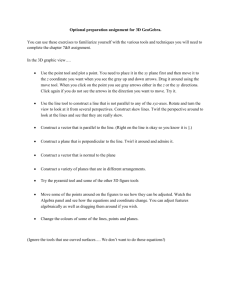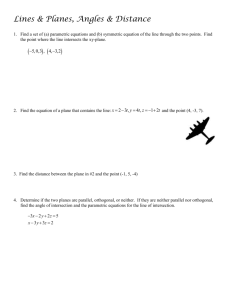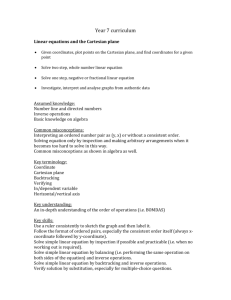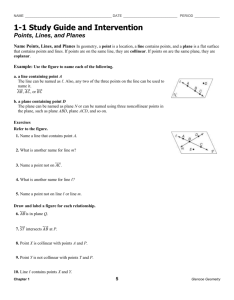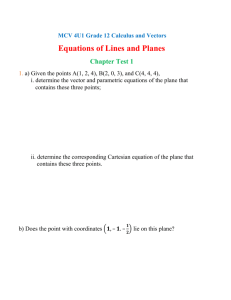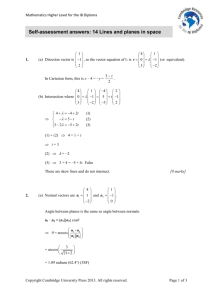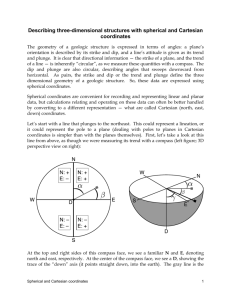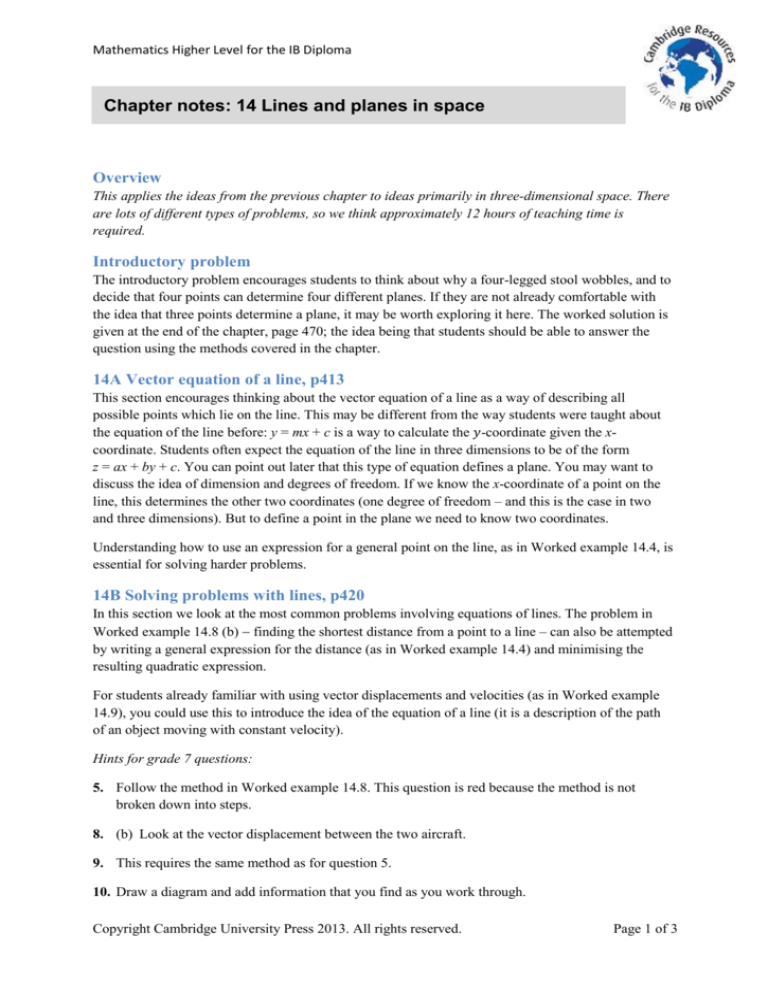
Mathematics Higher Level for the IB Diploma
Chapter notes: 14 Lines and planes in space
Overview
This applies the ideas from the previous chapter to ideas primarily in three-dimensional space. There
are lots of different types of problems, so we think approximately 12 hours of teaching time is
required.
Introductory problem
The introductory problem encourages students to think about why a four-legged stool wobbles, and to
decide that four points can determine four different planes. If they are not already comfortable with
the idea that three points determine a plane, it may be worth exploring it here. The worked solution is
given at the end of the chapter, page 470; the idea being that students should be able to answer the
question using the methods covered in the chapter.
14A Vector equation of a line, p413
This section encourages thinking about the vector equation of a line as a way of describing all
possible points which lie on the line. This may be different from the way students were taught about
the equation of the line before: y = mx + c is a way to calculate the 𝑦-coordinate given the xcoordinate. Students often expect the equation of the line in three dimensions to be of the form
z = ax + by + c. You can point out later that this type of equation defines a plane. You may want to
discuss the idea of dimension and degrees of freedom. If we know the x-coordinate of a point on the
line, this determines the other two coordinates (one degree of freedom – and this is the case in two
and three dimensions). But to define a point in the plane we need to know two coordinates.
Understanding how to use an expression for a general point on the line, as in Worked example 14.4, is
essential for solving harder problems.
14B Solving problems with lines, p420
In this section we look at the most common problems involving equations of lines. The problem in
Worked example 14.8 (b) finding the shortest distance from a point to a line – can also be attempted
by writing a general expression for the distance (as in Worked example 14.4) and minimising the
resulting quadratic expression.
For students already familiar with using vector displacements and velocities (as in Worked example
14.9), you could use this to introduce the idea of the equation of a line (it is a description of the path
of an object moving with constant velocity).
Hints for grade 7 questions:
5. Follow the method in Worked example 14.8. This question is red because the method is not
broken down into steps.
8. (b) Look at the vector displacement between the two aircraft.
9. This requires the same method as for question 5.
10. Draw a diagram and add information that you find as you work through.
Copyright Cambridge University Press 2013. All rights reserved.
Page 1 of 3
Mathematics Higher Level for the IB Diploma
11. (c) Draw a diagram and notice that QM MR .
12. Notice that the coordinates of P are obvious. You will need to use a general expression for PR .
14C Other forms of equation of a line, p432
This section introduces parametric and Cartesian equations. Students need to be familiar with these
names, and know how to convert between different forms.
The ‘Exam hint’ on page 435 gives a shortcut for going from a vector equation to a Cartesian
equation. But it is recommended that the students understand the full procedure. The issue of
‘dividing by zero’ – that is, writing the Cartesian equation from Worked example 14.10 as
3x 3 2 y 1 z 3
– appeared in a 2012 exam paper.
1
10
0
The examples in this section should show which form of equation is useful in which situation, but
there is not a definitive rule for this.
14D Equation of a plane, p439
The first part of the section looks at two ways of defining a plane: using three points, or a point and a
line. Determining a plane using two intersecting lines is discussed in section 14G (as it requires the
use of a normal vector).
The second part of the section introduces the normal vector as a way of describing the ‘direction’ of
the plane. This leads to the Cartesian equation of a plane, which gives a relationship between the
three coordinates of a point in the plane. We can link this back to the discussion of degrees of freedom
in section 14A – from the Cartesian equation of a plane, we need to know two coordinates of a point
in order to determine the third one.
There are no examination-style questions in this section. This is because the process of finding the
equation of a plane generally tends to be a part of a longer question.
14E Angles and intersections between lines and planes, p449
This section presents the methods for solving basic problems with lines and planes. They should be
viewed as tools to be used to answer the harder questions in section 14G.
You may need to challenge the students’ belief that the only way of finding the intersections of two
objects is ‘to make equations equal to each other’, and remind them about the idea of a substitution
from Chapter 4.
Note the two possible methods for finding the line of intersection of two planes, shown in Worked
examples 14.22 and 14.23. It is always worth discussing the advantages and disadvantages of each
alternative method.
Hints for grade 7 questions:
The difficulty in all of these questions is in deciding what calculation to do. A diagram nearly always
helps. You should emphasise that diagrams do not need to be accurate, but should show all the
features relevant to the question.
Copyright Cambridge University Press 2013. All rights reserved.
Page 2 of 3
Mathematics Higher Level for the IB Diploma
9. (b) Use the fact that sin θ = cos(90° − θ).
(c) Draw a diagram.
10. (d) A line parallel to two planes will be parallel to their line of intersection.
11. (c) This question leads you through finding the intersection of three planes by intersecting two of
them, and then intersecting the third one with the resulting line.
14F Intersection of three planes, p457
This is an extension of the work from section 4F on Gaussian elimination. As the syllabus does not
include matrices any more, we do not show determinant methods for deciding whether the three
planes intersect in a single point. Calculator use should be emphasised, although questions on this
topic may also appear in the non-calculator paper.
Hints for grade 7 questions:
9. (a) Perform Gaussian elimination.
10. (a) Perform Gaussian elimination.
14G Strategies for solving problems with lines and planes, p463
Questions on lines and planes can be difficult because situations may be hard to visualise and it is not
always clear what calculation needs to be performed. Many questions involve building up a strategy
from a sequence of relatively simple steps. The hardest questions require a good understanding of
how geometric properties are expressed using equations, for example using the scalar product to
express the fact that lines are perpendicular.
We have not included any Worked examples in this section, as we wanted to avoid the ‘six different
types of exam question’ approach. Instead, we hope to develop understanding by explaining the
reasoning behind some of the common strategies.
Hints for grade 7 questions:
7. (f) The volume of the pyramid is
1
(area of base) × (height). You will need the results from some
3
of the previous parts.
8. (b) A normal to the plane is perpendicular to every line on the plane.
9. (a) Line l has the same direction as the normal to the plane.
10. (b) A line perpendicular to a plane is in the same direction as the plane’s normal.
Copyright Cambridge University Press 2013. All rights reserved.
Page 3 of 3


